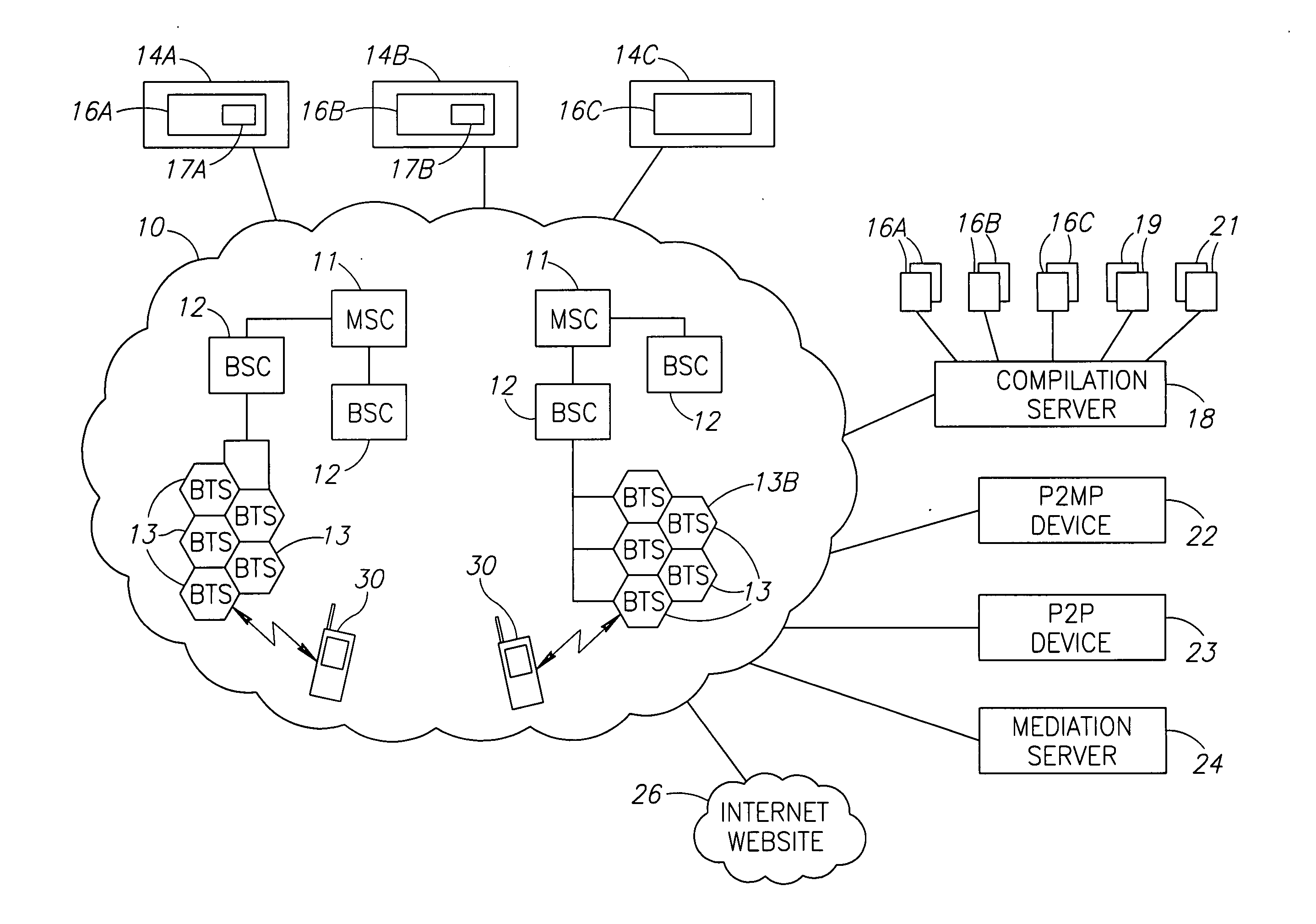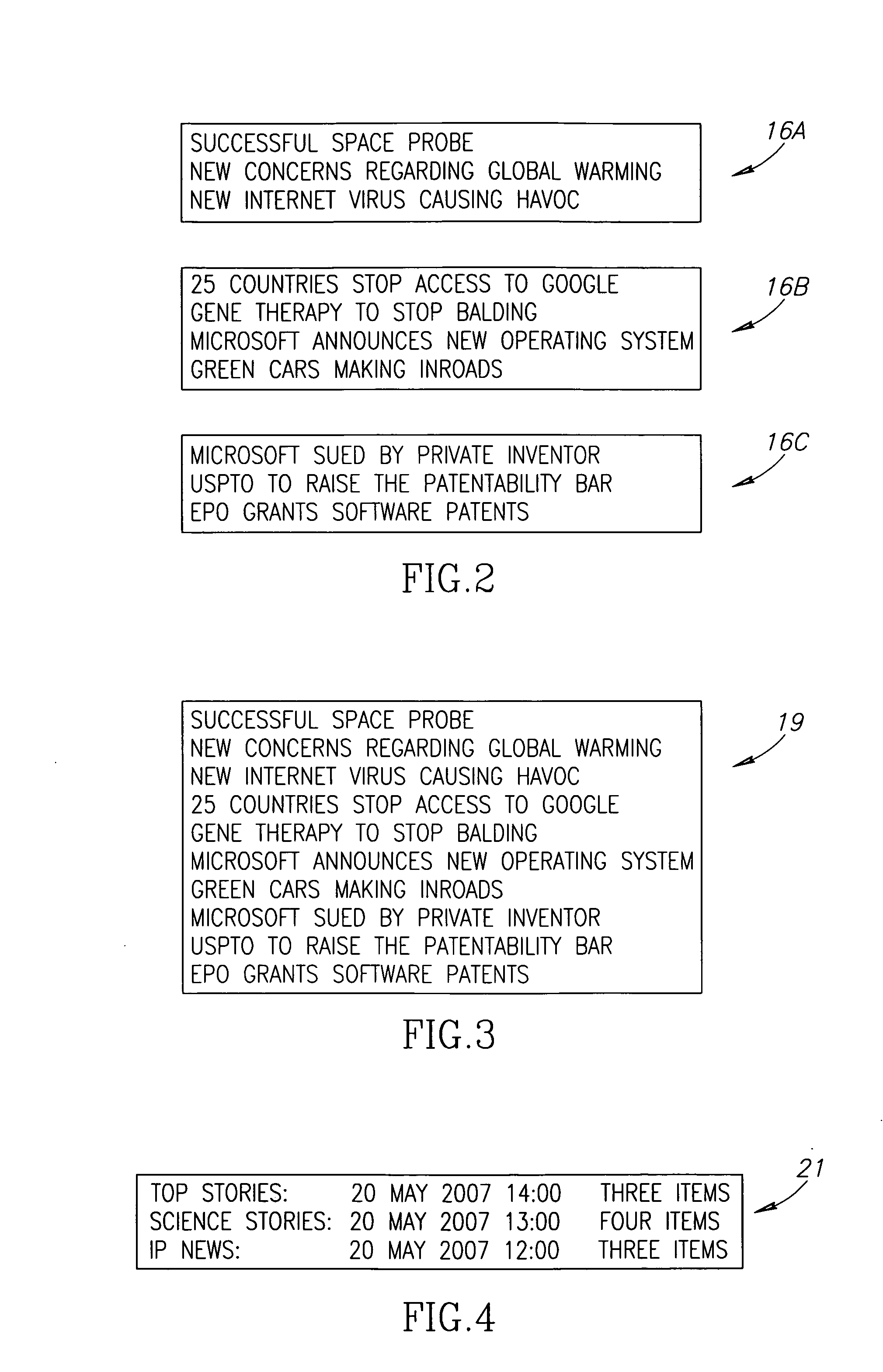[0009]Generally speaking, the present invention is directed toward facilitating web
content distribution to personal cellular telecommunications devices (hereinafter abbreviated to “devices”) each having feed reader functionality and browser functionality to benefit the entire web content supply chain, namely, syndication feed providers, cellular operators and cellular users. The present invention proposes deploying a compilation
server for periodically executing P2P syndicated information pull transactions at one or more syndication feeds in a conventional manner for periodically compiling one or two types of compilation files for transmitting to personal cellular telecommunications devices for provisioning cellular users with the most recent syndicated information files available at syndication feeds but lessening the present need for
mass fetching of syndicated information files on an individual typically automatic basis. It should be noted though that cellular users are still free to individually fetch syndicated information files in the conventional manner irrespective of whether they are receiving compilation files. Compilation servers can periodically prepare single compilation files covering a wide range of topics or alternatively several compilation files each dedicated towards a different topic, for example, top stories, sport news,
financial news, and the like. Users can place requests that syndication feeds be added to lists of syndication feeds interrogated by compilation servers. Alternatively, compilation servers can sniff syndication feeds from which syndicated information files are fetched by conventional P2P syndicated information pull transactions.
[0013]Syndicated items compilation files contain syndicated items compiled from one or more syndicated information files and are intended for Point-To-MultiPoint (P2MP) pushing to all available devices in one or more cells selected by a cellular operator. Compilation servers are preferably programmed to run a comparison check to determine which syndication feeds have been updated since the last fetching of their syndicated information files before compiling a syndicated items compilation file. Such comparison checks are preferably executed on a regular basis, say, once an hour on the hour. Compilation servers can be programmed to compile syndicated items compilation files from the same predetermined
list of syndication feeds if one or more of the syndication feeds from which they are fetching their most recent syndicated information files has been updated. Alternatively, compilation servers can be programmed to compile syndicated items compilation files containing only syndicated items from syndication feeds which have been updated since the last fetching of most recent syndicated information files to reduce their size. Consequently, consecutively compiled syndicated items compilation files may be partially or wholly different depending on compilation strategy and the update rates at the different syndication feeds from which syndicated information files are being fetched. The same syndicated items compilation file can be transmitted several times to increase the likelihood that it is received. Moreover, feed reader functionalities can include a log of when they receive syndicated items compilation files such that cellular users can be informed of same before deciding to individually fetch a syndicated information file from a syndication feed polled by a compilation
server. Individually fetched syndicated information files will either be the same version as the latest version fetched by a compilation
server or a newer version in the case that a syndication feed was updated after the last fetch by the compilation server. Feed reader functionality is programmed to process the syndicated items of the most recent syndicated information file available at a syndication feed irrespective of whether they are received in a syndicated items compilation file or an individually fetched syndicated information file. It is envisaged that the vast majority of syndicated items from most recent syndicated information files available at syndication feeds will be automatically brought to feed readers in syndicated items compilation files thereby reducing the number of P2P syndicated information pull transactions executed by personal cellular telecommunications devices to reduce the load along the entire web content supply chain.
[0015]Status notification compilation files contain a list of one or more syndication feeds together with status information regarding same, for example, last update time, last update identification serial number, file content
checksum, and the like, for enabling convenient determination at individual personal cellular telecommunications devices whether or not their feed reader functionality has processed the most recent syndicated information files available at one or more selected syndication feeds. Status notification compilation files are intended to be frequently compiled, for example, every five minutes, and can be either P2P pulled by particular devices or P2P pushed to particular devices or P2MP pushed to all available devices in one or more cells selected by a cellular operator. The same status notification compilation file can be P2P or P2MP pushed several times to increase the likelihood that it is received. Such status notification compilation files have the benefit of being typically much smaller than syndicated information files and are intended for relatively quick compilation and transmission to cellular users whilst consuming minimal transmission resources. Such status notification compilation files can contain status information regarding the same list of syndication feeds irrespective of whether some or all of the syndication feeds have or have not been updated since the last fetching of their most recent syndicated information files. Alternatively, status notification compilation files can contain status information regarding syndication feeds which have been updated since the last fetching of their most recent syndicated information files only.
[0016]Status information regarding syndication feeds can be processed at personal cellular telecommunications devices in one of several operational
modes which may be under
user control at their personal cellular telecommunications devices. For example, feed reader functionality may automatically fetch the most recent syndicated information files available at selected syndication feeds. Some cellular users may select to be advised regarding such fetching such that they are continuously informed regarding the status of the syndicated information files held at their feed reader functionality. Alternatively, some cellular users may request that their feed reader functionality request user
authorization before automatically fetching syndicated information files so that they may decline fetching a syndicated information file, for example, in the case that they know that they won't have the time to review its syndicated items. Alternatively, some cellular users may prefer that they be prompted with a list of one or more syndication feeds which have more recent syndicated information files available than those most recently processed by their personal cellular telecommunications devices whereupon they can decide if they want to fetch one or more of them. It is envisaged that the status notification compilation files of the present invention will afford cellular users the feeling that they have more hands on control over the operation of their feed reader functionality and will more selectively fetch most recent syndicated information files available at syndication files compared to the present automatic
mass fetching of syndicated information files irrespective of whether cellular users are likely to review them in the near future or not. Thus, it is envisaged that the status notification compilation files of the present invention will also assist reducing the number of P2P syndicated information pull transactions executed by personal cellular telecommunications devices to reduce the load along the entire web content supply chain.
 Login to View More
Login to View More  Login to View More
Login to View More 


